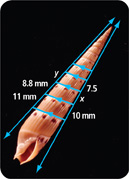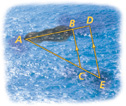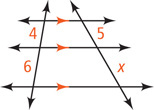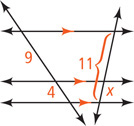 Practice and Problem-Solving Exercises
Practice and Problem-Solving Exercises
A Practice
See Problem 1.
Algebra Solve for x.
See Problem 2.
Marine Biology Use the information shown on the auger shell.

- What is the value of x?
- What is the value of y?
Algebra Solve for x.
See Problem 3.
Algebra Solve for x.
-

-

-

-

- Writing The size of an oil spill on the open ocean is difficult to measure directly. Use the figure below to describe how you could find the length of the oil spill indirectly. What measurements and calculations would you use?
- The lengths of the sides of a triangle are 5 cm, 12 cm, and 13 cm. Find the lengths, to the nearest tenth, of the segments into which the bisector of each angle divides the opposite side.

Table of Contents
Prentice Hall Geometry
Selected Answers
Index
Acknowledgments
Contents in Brief
Series Authors
Consulting Authors
Program Authors
Reviewers National
From the Authors
PowerGeometry.com
Big Ideas
Exploring Concepts
Thinking Mathematically
Active Learning
Practice Makes Perfect
Pearson Video Challenge
Acing the Test
BIG ideas
Entry-Level Assessment
Chapter 1 Tools of Geometry
Get Ready!
1-1 Nets and Drawings for Visualizing Geometry
1-2 Points, Lines, and Planes
1-3 Measuring Segments
1-4 Measuring Angles
1-5 Exploring Angle Pairs
1 Mid-Chapter Quiz
Concept Byte: Compass Designs
1-6 Basic Constructions
Concept Byte: Exploring Constructions
1-7 Midpoint and Distance in the Coordinate Plane
Review: Classifying Polygons
1-8 Perimeter, Circumference, and Area
Concept Byte: Comparing Perimeters and Areas
1 Pull It All Together
1 Chapter Review
1 Chapter Test
1 Cumulative Test Prep
Chapter 2 Reasoning and Proof
Get Ready!
2-1 Patterns and Inductive Reasoning
2-2 Conditional Statements
Concept Byte: Logic and Truth Tables
2-3 Biconditionals and Definitions
2 Mid-Chapter Quiz
2-4 Deductive Reasoning
2-5 Reasoning in Algebra and Geometry
2-6 Proving Angles Congruent
2 Pull It All Together
2 Chapter Review
2 Chapter Test
2 Cumulative Test Prep
Chapter 3 Parallel and Perpendicular Lines
Get Ready!
3-1 Lines and Angles
Concept Byte: Parallel Lines and Related Angles
3-2 Properties of Parallel Lines
3-3 Proving Lines Parallel
3-4 Parallel and Perpendicular Lines
Concept Byte: Perpendicular Lines and Planes
3-5 Parallel Lines and Triangles
Concept Byte: Exploring Spherical Geometry
3 Mid-Chapter Quiz
3-6 Constructing Parallel and Perpendicular Lines
3-7 Equations of Lines in the Coordinate Plane
3-8 Slopes of Parallel and Perpendicular Lines
3 Pull It All Together
3 Chapter Review
3 Chapter Test
3 Cumulative Test Prep
Chapter 4 Congruent Triangles
Get Ready!
4-1 Congruent Figures
Concept Byte: Building Congruent Triangles
4-2 Triangle Congruence by SSS and SAS
4-3 Triangle Congruence by ASA and AAS
Concept Byte: Exploring AAA and SSA
4 Mid-Chapter Quiz
4-4 Using Corresponding Parts of Congruent Triangles
Concept Byte: Paper-Folding Conjectures
4-5 Isosceles and Equilateral Triangles
Algebra Review: Systems of Linear Equations
4-6 Congruence in Right Triangles
4-7 Congruence in Overlapping Triangles
4 Pull It All Together
4 Chapter Review
4 Chapter Test
4 Cumulative Test Prep
Chapter 5 Relationships Within Triangles
Get Ready!
Concept Byte: Investigating Midsegments
5-1 Midsegments of Triangles
5-2 Perpendicular and Angle Bisectors
Concept Byte: Paper Folding Bisectors
5-3 Bisectors in Triangles
Concept Byte: Special Segments in Triangles
5-4 Medians and Altitudes
5 Mid-Chapter Quiz
5-5 Indirect Proof
Algebra Review: Solving Inequalities
5-6 Inequalities in One Triangle
5-7 Inequalities in Two Triangles
5 Pull It All Together
5 Chapter Review
5 Chapter Test
5 Cumulative Test Prep
Chapter 6 Polygons and Quadrilaterals
Get Ready!
Concept Byte: Exterior Angles of Polygons
6-1 The Polygon Angle-Sum Theorems
6-2 Properties of Parallelograms
6-3 Proving That a Quadrilateral Is a Parallelogram
6-4 Properties of Rhombuses, Rectangles, and Squares
6-5 Conditions for Rhombuses, Rectangles, and Squares
6-6 Trapezoids and Kites
6 Mid-Chapter Quiz
Algebra Review: Simplifying Radicals
6-7 Polygons in the Coordinate Plane
6-8 Applying Coordinate Geometry
Concept Byte: Quadrilaterals in Quadrilaterals
6-9 Proofs Using Coordinate Geometry
6 Pull It All Together
6 Chapter Review
6 Chapter Test
6 Cumulative Test Prep
Chapter 7 Similarity
- 6-1 The Polygon Angle-Sum Theorems
- 6-2 Properties of Parallelograms
- 6-3 Proving That a Quadrilateral Is a Parallelogram
- 6-4 Properties of Rhombuses, Rectangles, and Squares
- 6-5 Conditions for Rhombuses, Rectangles, and Squares
- 6-6 Trapezoids and Kites
- 6-7 Polygons in the Coordinate Plane
- 6-8 and 6-9 Coordinate Geometry and Coordinate Proofs
Get Ready!
7-1 Ratios and Proportions
Algebra Review: Solving Quadratic Equations
7-2 Similar Polygons
Concept Byte: Fractals
7-3 Proving Triangles Similar
7 Mid-Chapter Quiz
7-4 Similarity in Right Triangles
Concept Byte: The Golden Ratio
Concept Byte: Exploring Proportions in Triangles
7-5 Proportions in Triangles
7 Pull It All Together
7 Chapter Review
7 Chapter Test
7 Cumulative Test Prep
Chapter 8 Right Triangles and Trigonometry
Get Ready!
Concept Byte: The Pythagorean Theorem
8-1 The Pythagorean Theorem and Its Converse
8-2 Special Right Triangles
Concept Byte: Exploring Trigonometric Ratios
8-3 Trigonometry
8 Mid-Chapter Quiz
Concept Byte: Measuring From Afar
8-4 Angles of Elevation and Depression
Concept Byte: Law of Sines and Law of Cosines
8-5 Vectors
8 Pull It All Together
8 Chapter Review
8 Chapter Test
8 Cumulative Test Prep
Chapter 9 Transformations
Get Ready!
9-1 Translations
Concept Byte: Paper Folding and Reflections
9-2 Reflections
9-3 Rotations
Concept Byte: Tracing Paper Transformations
9-4 Symmetry
9 Mid-Chapter Quiz
9-5 Dilations
Concept Byte: Transformations Using Vectors and Matrices
9-6 Compositions of Reflections
Concept Byte: Frieze Patterns
Concept Byte: Creating Tessellations
9-7 Tessellations
9 Pull It All Together
9 Chapter Review
9 Chapter Test
9 Cumulative Test Prep
Chapter 10 Area
Get Ready!
Concept Byte: Transforming to Find Area
10-1 Areas of Parallelograms and Triangles
10-2 Areas of Trapezoids, Rhombuses, and Kites
10-3 Areas of Regular Polygons
10-4 Perimeters and Areas of Similar Figures
10 Mid-Chapter Quiz
10-5 Trigonometry and Area
10-6 Circles and Arcs
Concept Byte: Circle Graphs
Concept Byte: Exploring the Area of a Circle
10-7 Areas of Circles and Sectors
Concept Byte: Exploring Area and Circumference
10-8 Geometric Probability
10 Pull It All Together
10 Chapter Review
10 Chapter Test
10 Cumulative Test Prep
Chapter 11 Surface Area and Volume
Get Ready!
11-1 Space Figures and Cross Sections
Concept Byte: Perspective Drawing
Algebra Review: Literal Equations
11-2 Surface Areas of Prisms and Cylinders
11-3 Surface Areas of Pyramids and Cones
11 Mid-Chapter Quiz
11-4 Volumes of Prisms and Cylinders
Concept Byte: Finding Volume
11-5 Volumes of Pyramids and Cones
11-6 Surface Areas and Volumes of Spheres
Concept Byte: Exploring Similar Solids
11-7 Areas and Volumes of Similar Solids
11 Pull It All Together
11 Chapter Review
11 Chapter Test
11 Cumulative Test Prep
Chapter 12 Circles
Get Ready!
12-1 Tangent Lines
Concept Byte: Paper Folding With Circles
12-2 Chords and Arcs
12-3 Inscribed Angles
12 Mid-Chapter Quiz
Concept Byte: Exploring Chords and Secants
12-4 Angle Measures and Segment Lengths
12-5 Circles in the Coordinate Plane
12-6 Locus: A Set of Points
12 Pull It All Together
12 Chapter Review
12 Chapter Test
End-of-Course Assessment
Skills Handbook
Using a Ruler and Protractor
Classifying Triangles
Measurement Conversions
Measurement, Rounding Error, and Reasonableness
The Effect of Measurement Errors on Calculations
Squaring Numbers and Finding Square Roots
Evaluating and Simplifying Expressions
Simplifying Ratios
Absolute Value
The Coordinate Plane
Solving and Writing Linear Equations
Percents
Probability
Reference
Table 1 Measures
Table 2 Formulas
Table 3 Reading Math Symbols
Table 4 Properties of Real Numbers
Postulates, Theorems, and Constructions
Visual Glossary












